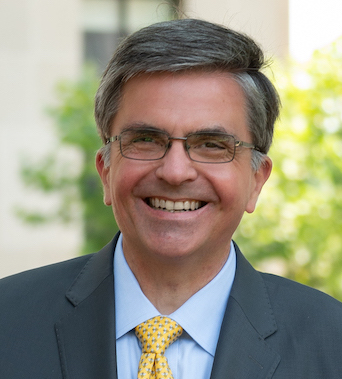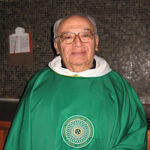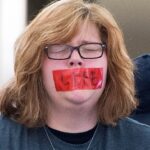My grandfather’s great uncle, who shared my last name, was a Methodist Sunday school superintendent, successful farmer, lifelong Republican, local public office holder, esteemed community leader, and a Ku Klux Klan member. The Klan officiated his January 11, 1924, funeral at a Methodist church in Columbus, Indiana, which appeared on the frontpage of the town’s newspaper, The Evening Republican. It reported that the rites were “impressive and solemn, made all the more so by the presence of many Klansmen and Klanswomen.
Before the church service, forty Klansmen marched through town to the church, where special music came from a Klan quartet. A “fiery cross” was taken the previous night to the home of the deceased by “masked Klansmen” and later placed at the grave. After the church service, Klan rituals were conducted at the cemetery. Four Klan officials including the “exalted cyclops, the klud, the klokard, and the klaliff,” stood at the four corners of the casket. Other berobed Klansmen served as pallbearers and surrounded the grave in a circle.
Another newspaper article, also on the front page, and noting the Klan funeral, recalled the deceased had been “kind and considerate, a good neighbor, and a person who at all times worked towards the betterment of his community, as well as for betterment of humanity.”
In the 1920s in Indiana, and many other places across America, many “kind and considerate” people belonged to the Klan during its resurgence. It was perhaps strongest in Indiana, where it virtually ran the state. A Fever in the Heartland: The Ku Klux Klan’s Plot to Take Over America, and the Woman Who Stopped Them, by Timothy Egan, tells the remarkable story of when much of America went mad, recovered, and then moved on. The era is perhaps instructive for today, and maybe even encouraging.
After receding in the South after Reconstruction, the Klan again became a mighty force after World War I, especially in the Midwest. It remained anti-black but anti-Catholic, anti-Jew and anti-immigrant became main concerns, particularly after several decades of high immigration. Many northern Protestants feared their hegemony was now threatened. To be American was to be a white Protestant. An estimated one of every three white men in Indiana joined the Klan, which virtually ran the state for several years, under the boot of a brilliant and cruel charlatan named D.C. Stephenson, Indiana’s KKK Grand Dragon.
The Klan virtually controlled Indiana’s Republican party, with Stephenson exerting a near veto over legislation and candidacies. (The Klan was much less successful in passing legislation.) He himself had national and even presidential aspirations. Although Stephenson was a drunken rapist who liked to bite his female victims, the Klan touted Protestant morality. It vigorously supported Prohibition, its self-appointed vigilantes smashing liquor stills and assaulting the sexually profligate. The Klan as a civic group and subculture appealed to men, women, and children. Its rites and rallies enlivened the tedium of smalltown America, offering an electrifying national purpose. America had enemies to be vanquished, and the Klan was the white knight.
In northern cities, with large populations of Catholics, Jews, blacks and immigrants, politicians and media were confident in attacking the Klan. In South Bend, Indiana, despite warnings from their Catholic school’s president to stay in their dorms, University of Notre Dame students mobbed Klan marchers, who retreated from town. But in most overwhelmingly white Protestant small towns, attacking the Klan was equivalent to attacking the Boy Scouts, the American Legion, or the Kiwanis Club. It became a pillar of civic life, but with malevolence and intimidation. A small-town newspaper or group of responsible citizens might want to defy the Klan. But such defiance was hard if Klan membership included the mayor, city council, police chief, prosecuting attorney, leading businessmen and other community stalwarts. Klansmen could threaten boycotts or physical violence, often without fear of community or legal repercussions. Isolated Catholics, Jews and blacks in small towns often were forced to pay protection money to the Klan. The Klan was literally next door, as one Catholic little boy realized when his kindly woman neighbor, returning from a Klan parade, removed her Klan hood on her front porch as he watched.
The 1924 Democratic Convention, after intense debate, failed by a narrow vote to denounce the Klan. Urban machines, relying on Catholics, Jews, and immigrants, and sometimes blacks, led by New York Mayor Al Smith, a Catholic, favored denunciation. Southern and Midwestern Protestants, led by perennial presidential candidate and evangelical Christian orator Williams Jennings Bryan, successfully argued against. Bryan insisted that Catholics and Jews, with their majestic traditions, did not need such a resolution. He did not mention blacks. Republicans, counting on Klan votes and patronage in places like Indiana, stayed silent.
Indiana Grand Dragon Stephenson, who reputedly controlled the Klan in twenty-one states, liked to boast, from behind the drawn curtains of his pillared white Indiana mansion, that he could phone Calvin Coolidge or any other national leader from the multiple phones on his desk. Almost certainly he was exaggerating, but he was understandably believed. His home was a party house for his many supplicants, whom he plied with alcohol and available women, also providing him with fodder for blackmail. Stephenson himself raped women without fear of prosecution.
But in 1925, one of his rape victims, who was also poisoned by alcohol, lived long enough and was brave enough to give devastating testimony from her death bed. Stephenson’s trial for abduction, rape and murder was national news. He was pampered in his jail cell, expecting acquittal. Instead, he would serve 30 years in prison. Refused a pardon by the governor he helped elect, Stephenson released hordes of dirt on politicians he had patronized, including the governor, sealing the Klan’s doom in Indiana, and leading to its quick national demise.
The courageous prosecutor who successfully pursued Stephenson’s conviction would years later visit the prisoner. He asked Stephenson if he had been serious about running for president. Yes, he responded but “you wouldn’t have called it President. The form of government might have changed. You might have had a dictator.”
This book notes the Klan was built on Protestant support, which sadly included clergy. The pastor of First Christian Church in Noblesville, Indiana, the town’s largest congregation, preached a pro-Klan sermon against the “poison of the melting pot.” And he concluded: “I would rather wear a white sheet in the dark than see my country in a shroud.” Not always relying on natural sympathy, the Klan often interrupted worship services with a Klan procession, presenting the pastor with an envelope full of cash. The exercise was both bribe and intimidation. Clergy were seen as key influencers. The lawyer of Stephenson’s rape/murder victim had quit his Methodist church after the pastor accepted such a bribe. But the book might be unfair in overlooking Protestant resistance to the Klan. For example, Chicago’s Methodist bishop in 1925 denounced the Klan and its ideas of “Anglo-Saxon superiority,” insisting that “it is not Anglo-Saxon blood, but the blood of Jesus Christ that has made us what we are.”
Perhaps the greatest epitaph on the Klan’s rise and fall was an Indiana writer asking, “Isn’t it strange that with all our educational advantages… Indiana citizens could be induced to pay $10 [Klan membership fee] for the privilege of hating their neighbors and wearing a sheet.”
Years ago, when I found my relative’s 1924 Klan obituary, I told my grandfather, who responded with surprise, noting he thought his family had been “classy” people. But plenty of “classy” people across America went crazy for several years before the insanity burned away. Insanities in America usually do, but often after great destruction.






Comment by David Wilson on November 13, 2024 at 9:23 pm
About 20 years ago in looking through my parish archives, I discovered that in the 1920s the Vestry Senior Warden (Chairman of the Board) of the Episcopal Church I served as rector (senior pastor) was a leader in the local Klan. It was a county seat parish in rural Western PA.
Comment by John on November 13, 2024 at 10:18 pm
Wish I could say we’ve come a long a way in the last century, but right now I’m not so sure.
Comment by David on November 13, 2024 at 10:19 pm
The Klan was active on the Jersey Shore as well. In 1924 and 1925, it was given permission by the Ocean Grove Camp Meeting Association [Methodist] to use the Great Auditorium for a meeting, though members did not wear regalia.
“We are not anti-Catholic, anti-Jew, anti-Negro nor anti-foreign born. The truth is, we are not anti-anything, but are a band of pro-Protestants and pro-Americans. There are 7,000,000 Klansmen in America, and all are on an equal basis; there is no class distinction.” Catholics are eliminated from membership, even as Protestants are eliminated from the Knights of Columbus and other Catholic organizations, each body having an unquestionable right to organize a society for the members of its own faith. The same with the Jew.”
The Auditorium was also used by Marian Anderson and Amanda Berry Smith (“the Negro Evangelist”), and the annual conventions of the African Methodist Church.